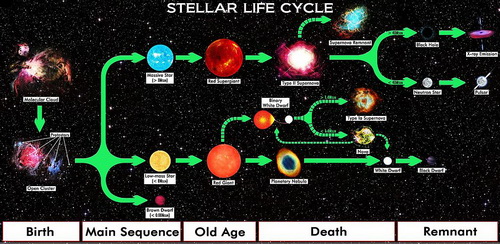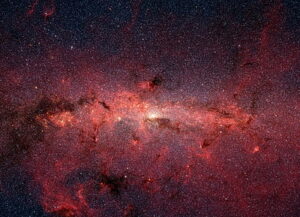
A star changes into several different phases before its death. Since it is our Sun that brings us life, as well as it being part of the main sequence category of stars, let’s use the sun as our example.
Early On
During the years following the big bang, giant clouds of hydrogen and helium atoms began to form. As the years followed, these elements started to clump together to form balls of hydrogen and helium gas. In other words, they became a mass of balls of gas. When the mass is created, gravity is established and the star cycle begins.
So a star is being formed and as such, our friend gravity keeps getting stronger as the mass of the star keeps getting bigger. When gravity reaches a certain strength, the star will collapse into itself. But wait! This won’t happen because there is a force that will counter the star’s gravitational pull. So what is this mysterious force?
What Stops Stars from Collapsing?
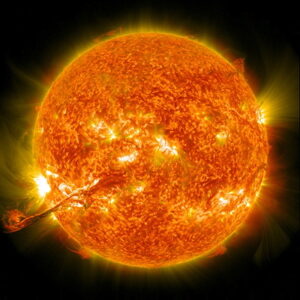
Enter nuclear fusion! This is where the hydrogen and helium atoms combine. Another way of describing this process is when the protons and neutrons, called nuclei of an atom (in this case hydrogen) fuse with the nuclei of another atom (in this case helium) to produce one heavier helium atom.
It is that simple… or is it? For the benefit of our audience, we will keep it simple by stating that each hydrogen atom is one ounce (of course this is not the actual weight) and when four of these atoms are combined into one larger atom, the resultant atoms would weigh four ounces. But no! The weight of the combined atom ends up being less than the combined weight of the four separate atoms. So, the mass that escapes when these nuclei combine is in the form of energy.
This is a prime example of Einstein’s formula E=mc2, which states that mass and energy are proportionally connected; that is, as mass decreases, energy increases and vice-versa. In the case of nuclear fusion, some of the mass of the helium nucleus is released and converted to energy.
Another way of describing this process is when a single nucleus combines to form two lighter nuclei. When this happens, energy is released because it gives off more heat than it needs and the result is energy.
If you’d like to get more insight into the actual process of nuclear fusion, then this fun video is for you.
So the result is that there is a balancing act where the inward pull of the star’s gravity and the outward push of the nuclear fusion process cancel out each of the forces. And that is why the Sun (and all stars) don’t collapse onto themselves (at least as long as there is hydrogen to fuel the nuclear fusion).
Let There Be Light!
If you follow the bible, God said “let there be light”. Maybe it is just a metaphor that explains what this cycle of energy is, but whether you believe in the bible or not, the fact remains that this energy that is produced is in the form of light. And there you have it! Light is created when hydrogen nuclei fuse with helium.
It’s All About Gravity
The Sun, like all stars, has a limited supply of hydrogen in its cores. When the star’s core runs out of hydrogen fuel, gravity takes hold and subsequently, the star will compress. The energy in the form of heat is then generated.
This heat caused the outer layers of the Sun to bulge out or expand across the inner part of our solar system to become what astronomers call a red giant. Big enough to engulf the orbits of Mercury and Venus and even reach Earth. Then, after millions of years, these outer layers of gas will dissipate into the darkness of the universe.
But let’s get back to what’s left of the star. It will collapse within itself to become a white dwarf, thanks again to gravity. As an example, picture a balloon that contains solid rock (it is just gas, but for this hyper-theoretical explanation, we will use a solid) that is pushed down to the size of a ping-pong ball.
This is referred to as a change in volume, which means that the same amount of rock in the balloon is condensed to the pong size. In scientific terms, it refers to the volume of the mass that is condensed (to a smaller size) and so, the tiny ball still weighs the same as when it was balloon size. The result is a heavier density of the mass which would be equivalent to that of one teaspoon of the material in the ping-pong ball that could weigh up to 100 tons. Over billions of years, the white dwarf cools and becomes invisible.
What About the Other Stars
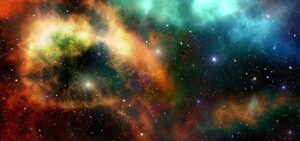
Now, let’s take a look at what happens to other stars in the universe. It all depends upon what size the star is during its main life cycle.
Superlarge stars will change into supernovae, not like our sun which is considered an average star. Its end life cycle will result in a white dwarf as we discussed. Regardless of the star’s size, all will follow a seven-cycle process. So without further ado, here are the life (and death) cycles of all stars.
1. Giant Gas Cloud

Nebulas are where stars are born. Similar to a fetus in a womb, the stars grow as the gas molecules work to form them. That is why it is called a gas cloud and we can thank gravity for bringing these molecules together.
2. Protostar
When the gas particles run into each other, heat is created. This result is what scientists call a Protostar – the beginning of a star’s creation. We can view this process via infrared since protostars show up warmer than the other materials in the nebula cloud.
3. T-Tauri Phase
T-Tauri stars are the next phase in the star’s life process, but not strong enough for nuclear fusion to begin. This cycle lasts about 100 million years.
4. Main Sequence
Welcome to the main sequence phase of stars and this is where our Sun is now; otherwise, you would not be here to read this article. Scientifically, it is the process where the core temperature has gone high enough to allow nuclear fusion to begin.
5. Red Giant
When the hydrogen fuel starts to run out, the nuclear fusion process will end its cycle. Now there is nothing to stop the star from condensing into itself because our friend – gravity has complete control with no force to counter it.
As the star contracts inward, the outer layers expand. This expansion is so great that it could reach the orbits of some of its inner planets.
Say hello to the red giant! When stars reach this phase, they appear yellowish since they are cooler than stars that are in their main-sequence stage.
6. The Fusion of Iron
The Helium molecules start combining at the star’s core, causing the core to shrink. When this happens, carbon is fused in and this process continues until the atoms turn into iron. Now the core will collapse as the iron fusion absorbs energy. This in turn causes this red giant to become a supernova., but for medium-sized stars like our Sun, the star will contract and turn into a white dwarf.
7. Supernovae
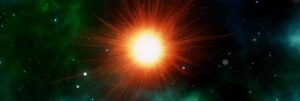
Some of the most spectacular events in galaxies is the occurrence of supernovae. In this phase, most of the star’s matter is blasted away into space, creating a giant blast that even the human eye can detect if it is within viewing distance.
What is happening is that the star runs out of energy; in other words, it is depleted of its fuel and subsequently collapses into itself, with all the electrons and protons compressing into a neutron and subsequently becoming a neutron star.
8. Stellar Nursery
No doubt you have seen nebulas in photos or maybe through a telescope. These are the stellar nurseries, where remnants of gas and other materials are floating around only to be gathered together again to form new stars.
